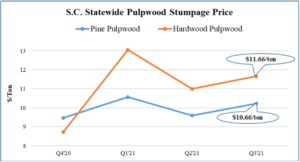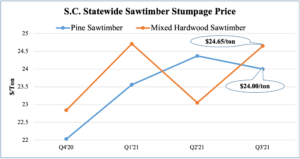
South Carolina Pulpwood Stumpage Price Trends: Statewide pulpwood stumpage prices for both pine and hardwood were higher than the rates observed in the previous quarter. On average, South Carolina statewide pine pulpwood prices were $10.66/ton in the 3rd quarter of 2021. On average, the statewide stumpage prices for mixed hardwood pulpwood were $11.66/ton in this quarter. Both prices were little over 6% than the rates observed in the previous quarter. These price increases indicate an improved stumpage market and economic activities in this quarter.

South Carolina Sawtimber Stumpage Prices Trends: Statewide pine stumpage prices observed less than a 2% decline in prices than the rates observed in the previous quarter, but the hardwood stumpage market had about a 7% increase in the rates from the previous quarter. On average, South Carolina statewide pine sawtimber stumpage prices were $24.00/ton in the 3rd quarter of 2021. For mixed hardwood, the statewide stumpage prices, on average, were $24.65/ton in this quarter. In the previous quarter, hardwood stumpage prices were lower than the pine stumpage prices, but the trend has reversed in this quarter. In general, the hardwood stumpage prices have increased about $5/ton than the rates observed in the same quarter (Q3) last year, while the pine stumpage prices have increased about $3/ton during this period. Forisk Wood Review report attributed multiple hurricanes events in the gulf coast region and limited wet weather harvesting opportunities for the sharp increase in hardwood prices this quarter. Forisk report link: https://forisk.com/blog/2021/10/05/q3-2021-forisk-wood-fiber-review-southern-prices-on-the-rise/
Carbon Market Updates: The size of forest holdings and long-term contract requirements had been bottlenecks for many forest landowners willing to participate in the carbon market. New carbon market opportunities have made it suitable for forest landowners with as low as 30-40 acres to earn extra revenue from carbon credits by delaying final harvest for few extra years. In general, there are two types of carbon markets – voluntary or compliance-driven (regulatory). California Cap-and-Trade program is the most widely known regulatory forest carbon market in North American. This carbon credit program, recognized by the California Air Resources Board, a gold standard in carbon credits, has rigorous requirements and broader recognition. It considers all properties in the United States but requires a 100-yr commitment to store and sequester carbon on the property. High up-front costs involved to verify and monitor carbon storage makes it more suitable for large acres. The average property size enrolled in this program was over 48,000 acres.
Voluntary carbon markets are often operated by private entities and offer more attractive terms to family forest landowners than the California Cap-and-Trade program. These markets are more suitable for small property owners (less than 100 acres) because of flexible time commitments. One example of a voluntary forest carbon market available for forest landowners in South Carolina is Natural Capital Exchange (NCX), previously knowns as SilviaTerra. Some of these voluntary programs offer commitments as short as one year.
Data credit: The sawtimber and pulpwood price data included in this newsletter are published with permission from TimberMart-South Athens, GA 30605 email tmart@timbermart-south.com.
Author(s)
Puskar Khanal, Cooperative Extension, Forestry and Wildlife Specialist
This information is supplied with the understanding that no discrimination is intended and no endorsement of brand names or registered trademarks by the Clemson University Cooperative Extension Service is implied, nor is any discrimination intended by the exclusion of products or manufacturers not named. All recommendations are for South Carolina conditions and may not apply to other areas.
Clemson University Cooperative Extension Service offers its programs to people of all ages, regardless of race, color, gender, religion, national origin, disability, political beliefs, sexual orientation, gender identity, marital or family status and is an equal opportunity employer.
